In January we took a flight down to the Rhone to spend some time with the Perrin family. Over the course of 24 hours we saw the traditions that have made Chateau de Beaucastel and the family’s other wines some of the most revered and well-known in the region, and critically how improvements are being made to maintain and increase their importance over the coming years.
The estate is founded around the vineyards of Beaucastel, the northern tip of the Chateauneuf du Pape region, exposed to the cooling Mistral which lowers the temperatures in the vineyards to aid ripeness at lower sugar levels. The vineyards surrounding the Chateau are as you would expect in the region, old vines planted at a low density with piles of galets, or pudding stones, surrounding the vines. They aid the retention of warmth during the evenings, but also improve drainage and, when piled around the vines, reduce the evaporation rates from the soil to reduce water stress in the hot, dry months of the summer. There are just over 100 hectares here, 70 of which are denoted for Chateauneuf du Pape and go into the Beaucastel wines, with the remaining 30 hectares used for the Coudoulet wines. Given that it is merely a road that splits the Coudoulet from Beaucastel, it is easy to see why these wines offer such great value for their quality level.
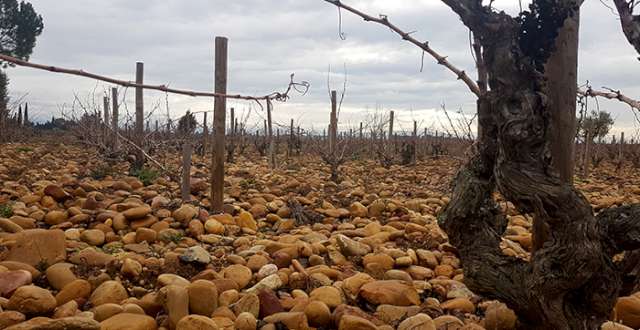
Old vignes and Galets, the stones that give Chateauneuf it's distinctive soil stype, in the heart of Beaucastel. |
All 13 permitted varieties are planted here, but it is notable that the percentage of old Mourvèdre is much higher than the regional average. This variety has seen a surge in popularity with the increasing temperatures in the region, with many Domaines pulling out Grenache to replace it with this heat-tolerant, later-ripening and lower alcohol variety now greatly appealing. When the Perrin family were planting these vines, it was still largely undervalued, thought to produce rustic, under-ripe, muscular wines without finesse. Now that their vines are an average of 70 years old, they are at a great advantage, with the vines producing such high quality fruit that it makes up roughly 30% of Beaucastel and Hommage à Jacques Perrin made from a majority of the variety. There are of course good levels of Grenache and Syrah also planted, as well as an old vineyard of Roussanne, first planted in 1909 and with an average age of 85 years that makes the varietal Vieilles Vignes wine. As the older vines in the vineyard need replanting they are replaced one by one and earmarked for the Les Sinards bottling, where they are blended with a neighbouring plot, until they reach 15 years of age.
The vineyard work is meticulous across the vineyards owned throughout the Rhone. Beaucastel has always been farmed organically, but every new purchase in the area is immediately converted to these practices where longer hours in the vineyard promote healthy grapes rather than the use of systemic chemicals. This includes the now 85 hectares of land bought in and around Vinsobres, from which come excellent bottlings such as the Vieilles Vignes Haut de Julien. The vineyards of Vinsobres are hilly and at times steep, with more clay in parts that meant we were sliding around in a pick-up truck given the recent (and much needed) rains. These vineyards are also noticeably cooler than those on the valley floor, another instance of the family’s foreward thinking when it comes to the climate in their region. There are many impressive sites, and seeing the 125 year old, ungrafted, gnarly Grenache used for the Gigondas l’Argnee, sitting atop sandy soils not dissimilar to that seen at Rayas, it is a wonder to think that the wines are still available (albeit in tiny quantities) at less than £350 a dozen. The dedication to old vines and low-chemical vineyard work puts quality far above efficiency or profitability.
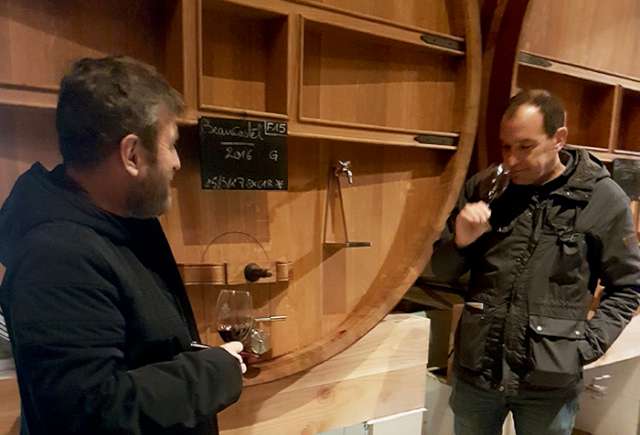
Stephen Browett tasting from the foudre with Marc Perrin |
The story is much the same in the winery. The grapes are sorted three times. Once in the vineyard, once on sorting tables before destemming (all but a small proportion of Syrah when stems are ripe is destemmed), and once after destemming to avoid berries with variable skin ripeness on either side making it into the wine. The heating tube for which Beaucastel is famous was installed to prevent contamination of unwanted bacteria and yeasts into the wine, as well as killing oxidases that could rapidly evolve the wine and remove primary aromas/colour. This heated the grapes to 79C before cooling them back down to 17C so that fermentation could start slowly. With better vineyard practices and more stringent selection in the winery, this tube is now only used for parcels with less-than-perfect fruit or that which is prone to oxidation, such as Grenache. The grapes are treated differently at this stage. The whites are pressed off the skins and sent to fermentation after a light bentonite fining, while the reds are split into different vats by variety/plot as appropriate. Syrah and Mourvèdre will go into foudres and be treated to more pigeage and pumpovers as they are more reductive grape varieties and will benefit from the air and extraction. Grenache will go into lined concrete vats with only one pumpover a day, and no pigeage. This prevents a variety prone to rapid oxidation deteriorating or losing primary character during fermentation.
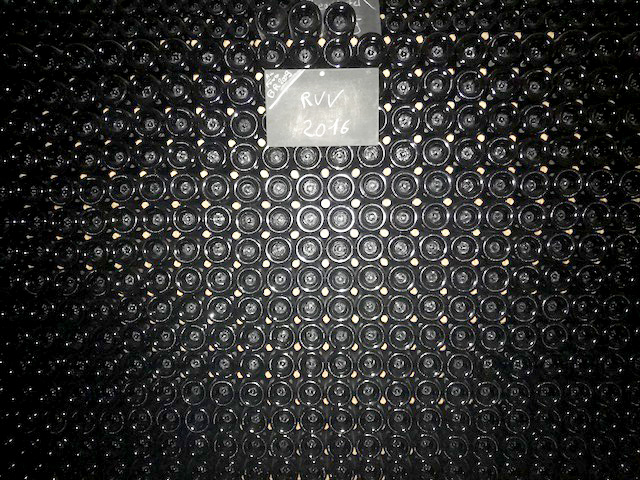
Stacked bottles of Roussanne Vieilles Vignes 2016 |
The blends will start to be made after the completion of malolactic fermentation, but this process can be timed differently depending on the vintage and other factors. The wines will remain in large foudres which are replaced once every 40 years so as to minimise the impact of oak. Some Syrah and Grenache for the wines from Vinsobres and Gigondas will have a proportion of new oak, but this is rarely if ever above 30%. Similarly, the Roussanne Vieilles Vignes can take up to 50% new oak given the fruit can take more of the spiciness this adds, revealing a style more similar to Grand Cru white Burgundy. The winemaking supports rather than dominates the fruit in each instance, allowing a true sense of place to shine through.
Below is a list of notes from the fantastic array of wines tasted over our time at the estate. Our thanks go to the Perrin family and everyone at the estate who welcomed us and looked after us so well.
Vinsobres Vieilles Vignes Les Hauts de Julien 2015
From 80 year old vines and with a high percentage of Syrah, this wine is aged in foudres for 12-14 months, with just a touch of new oak. This light spiciness is evident on the nose, complementing floral violet and blueberry notes and a good crunch of black pepper. The palate is refined, with ripe tannins framing lifted blue and black fruits with a hint of sweet smokiness. This is ripe and round but fine, with balancing acidity giving a fleet-footedness that cools the fruit and refreshes the palate. We loved this wine en primeur and it is now shining in the bottle.
Vinsobres Vieilles Vignes Les Hauts de Julien 2012
A bright purple colour in the glass denotes the high level of Syrah in the blend for this wine. Smoky on the nose, there are redolent red fruits and blueberries here. The fruit and tannins are soft on the palate, giving a silky texture and seamless balance, allowing the lightly meaty, gamey notes to complement the sweet red fruits. Smooth and lightly spicy on the finish, this is still largely primary but just starting to gain the complexity of age.
Gigondas Clos des Tourelles 2015
From a horse-ploughed vineyard, with 80% Grenache and 100% wholebunch. This wine is wonderfully aromatic on pouring, with garrigue and spicy green peppercorn, nutmeg and clove. The fruit is ripe and red – juicy red cherry and brambly raspberries show in great intensity. The wholebunch nature of this wine brings an almost Pinot Noir like quality to the nose. The fruit on the palate is high-toned and floral, with crunchy, chalky tannins framing a great intensity of fruit. This is full bodied but carries its weight with ease, filling out with oodles of red fruit and spices. The finish is long, vibrant and primary, with lingering herbal undertones. A knockout wine.
Gigondas Clos des Tourelles 2012
Much like the Vinsobres, the 2012 by comparison to the 2015 shows more red fruits, which are slightly dried in nature and revealing the early stages of development. There is lots of white pepper and savoury spice on the nose here too. The palate shows a hint of fresh and dried figs underneath juicy red cherries and strawberries. The tannins are soft and integrated, giving a full-bodied and round mouthfeel through to the finish. Plump and round, this a real hedonist’s wine.
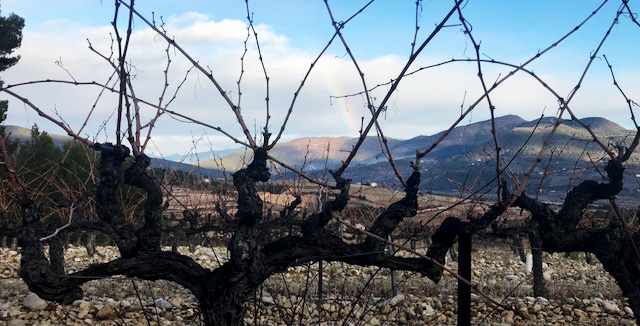
The old vines of Vinsobres at Hauts de Julien cast against a rainbow in the background. |
Gigondas L’Argnée Vieilles Vignes 2015
This is an extraordinary wine produced from pre-phylloxera Grenache vines that are over 125 years of age. The production of this rarely seen wine is just 100 cases per annum. The nose here is rich, brooding and powerful without being over-ripe. Strawberry and cherry blossom, with a hint of boysenberry and damson coming through. The palate is very concentrated and powerful while maintaining freshness. The tannins are plentiful but fine-grained and ripe framing a great intensity of fruit and spices. This richness is tamed, and well managed, with black fruits adding to the ripe cherry notes and bringing a sweetness that complements the layers of herbal and spicy complexity. Still extremely young, this wine has great length and intensity on the finish, suggesting a long life ahead.
CDP 2010 Chapouins Vieilles Vignes 2010
In the great 2010 vintage (for only the second time ever), the fruit from this small parcel of old vines situated on the edge of the Beaucastel estate was vinified separately and matured, undisturbed, in a single 4500 litre foudre in the cellars at the Château for over six years. In 2017 it was taken out of the foudre and finally bottled. The wine is a vibrant ruby in the glass, with just a touch of garnet at the rim. Immediately expressive and expansive on the nose, there are notes of red and black fruits which give way to layers of nutmeg, leather, and sous bois. The result is a ripe yet savoury bouquet that is incredibly enticing. Thanks to the extended ageing in foudre, the typically firm tannins of the 2010 vintage have mellowed and integrated wonderfully into the ripe core of fruit, allowing brambly sweetness to shine through the developed leather and lightly gamey, peppery notes. There is a myriad of flavours through the mid-palate and onto the finish, aided by the smooth texture and vibrant acidity. The finish is long, savoury, spicy, fruitful and somehow both youthful and mature. A wonderful, unique expression of Châteauneuf du Pape.
Coudoulet Blanc 2016
Peaches, pineapple and other tropical fruits leap from the glass on the nose, supported by lightly spice and nutty aromas. The palate is pithy and textural, offering more savoury character and body to support the ripe fruits through to a juicy yet savoury, long finish. A delicious drink that will be ready on release.
Beaucastel Blanc 2016
With a similar fruit profile to the Coudoulet, the Beaucastel Blanc offers much more spiciness and salinity on the nose, bringing a flinty minerality that makes it all the more enticing. The palate shows great tension for a white made in this heat, the oiliness tempered by more struck flint, juicy, peachy fruit and that saline edge. Lots of white pepper and non-fruit spiciness lingers on the finish. These wines are always delicious when young, which is by far our preferred time to drink them.
Roussanne Vieilles Vignes 2016
From the 3ha plot of vines planted in 1909, this 100% Roussanne is raised in 50% barriques. The nose is smoky, mineral and taut, revealing a light creaminess, lemon curd and an almost Burgundian savour in aroma. The palate is textural and broad, with the ripe fruit both deep and round, filling the mouth with bright stone and tropical fruits. Acidity cuts through on the mid-palate refreshing the ripeness with waves of zesty lemon and struck flint. The length and richness here is absolutely delicious already. Whilst you can age these wines, they are so delicious when young that we often wonder whether the first 5 years are when they show best.
Beaucastel Rouge 2009
The ripe nature of this vintage is shining through already, with notes of truffle just starting to show underneath layers of juicy, ripe red fruits. The palate is opulent, rich and round without being overdone. The tannins are already soft and silky, melted into the wine to such an extent that it is already approachable. The power and length of fruit shows that it will only improve in time, with the flavours still largely primary, but the slight notes of development make this a wonderful drink at this young stage.
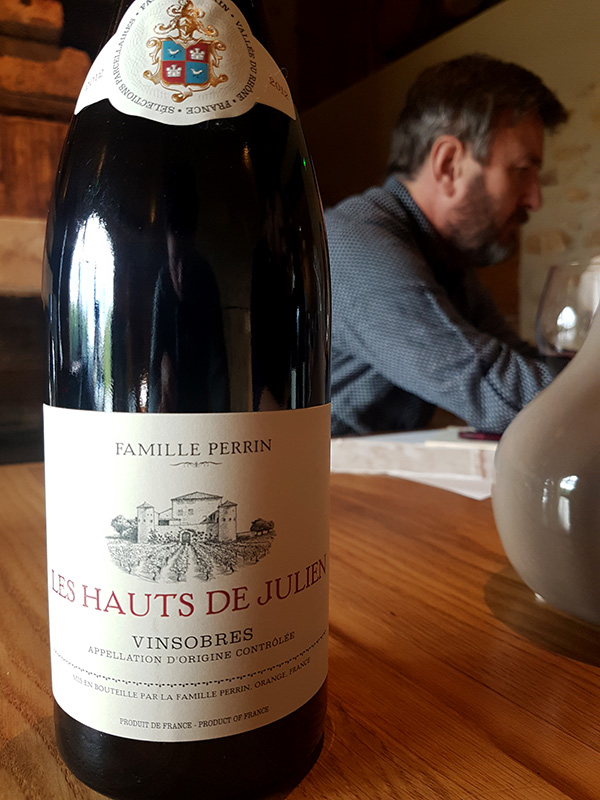
Stephen Browett tasting through the range of wines. |
Beaucastel Rouge 2005
Wild herbs, hedgerow fruit and blackberry compote here on the nose. The palate is bold and powerful, with rich tannins offering a muscular, youthful structure that will still need at least 3-5 years to settle. The fruit is still primary but quite wild and full of blossom and hedgerow fruit. Complex and robust, this is one for the future.
Beaucastel Rouge 2003
Sweet and very ripe, with notes of figs and nutmeg, this is a classic 2003 but with a hit of freshness that keeps it in check. The tannins are ripe and only give bite on the finish, allowing notes of damson, leather and savoury spices to come through. The finish is exuberant and round, one for the hedonists.
Beaucastel Rouge 2000
We are now in the wonderful secondary stage of great Beaucastel with this wine. Roasted game, peppered steak, bramble fruits and savoury spices on an expansive nose. The palate is silky with resovled tannins, juicy blackberry and black cherry, with roasted grouse, barbecued meats and exotic juniper and star anise all coming through. This is a wonderful expression of Beaucastel that will drink well from now over the next 5-10 years.
Hommage à Jacques Perrin 2001
Deep colour still. This is incredible. A nose of truffles, freshly picked blackberry, scorched earth and black peppercorn only builds in intensity with time in the glass. The palate has a myriad of layers. First, the textural notes come through with refined but firm tannins coating the palate and indicating the longevity that this wine still has – it is far from peak. The weight and power of the fruit builds on this – blackberry, liquorice, truffle, undergrowth and more all show through, tamed by balancing acidity. Meaty notes are just starting to come through and foreshadow the development of this wine. This is a multi-dimensional, truly outstanding wine, that could rub shoulders with any of the best from around the world.
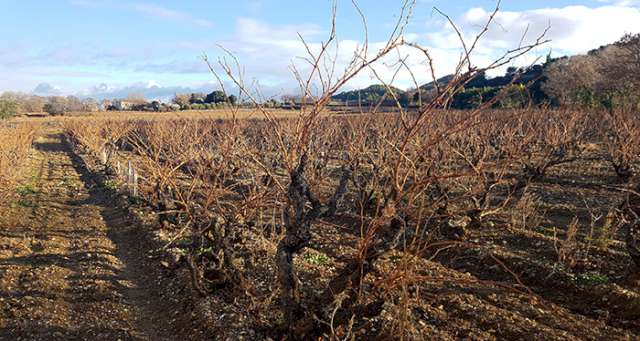
The extremely old vignes at Gigondas l'Argnée |